Categorization:Harness Component
Specializing in the production/sale of 50 Ω RF | microwave | millimeter wave high-precision coaxial cable | test cable and coaxial adapter; The frequency of the company's products covers DC-110GHz, mainly including high-performance RF cables, RF connectors, RF microwave cable components, microwave millimeter-wave devices, microwave millimeter-wave components, cryogenic electronic devices, RF coaxial switches, switch matrices, microwave antennas, optical interconnection products and other RF cable components and connectors! It is widely used in military industry, aerospace, satellite, radar, mobile network, broadband communication, big data, Internet of Things, quantum communication and other frontier scientific and technological fields.
1、 What is RF Cable? Radio frequency cable is a cable that transmits electromagnetic energy within the radio frequency range. Radio frequency cable is an indispensable component in various radio communication systems and electronic equipment. It is widely used in wireless communication, broadcasting, television, radar, navigation, computers and instruments. Product features: 1. Can transmit a wider frequency band 2. High degree of defense against external interference 3. Small antenna effect, small radiation loss 4. Simple structure, easy installation, more economical. The structure of RF cable is varied and can be classified according to different ways and types. (1) Coaxial RF cable Coaxial RF cable is the most commonly used type of structure. Because the inner and outer conductors are concentric, the electromagnetic energy is confined to the medium between the inner and outer conductors, so it has the advantages of small attenuation, high shielding performance, wide frequency band and stable performance. Commonly used to transmit radio frequency energy from 500 kilohertz to 18 gigahertz. At present, there are two kinds of commonly used RF coaxial cables: 50 Q and 75 Q RF coaxial cables. RF coaxial cable with characteristic impedance of 75Q is commonly used in CATV network, so it is called CATV cable. Its transmission bandwidth can reach 1GHz. At present, the transmission bandwidth of commonly used CATV cable is 750MHz. (2) Symmetrical RF cable The electromagnetic field of symmetrical RF cable loop is open. Due to the radiation of electromagnetic energy at high frequency, the attenuation is increased and the shielding performance is poor. In addition, the influence of atmospheric conditions is usually less used. Symmetrical RF cables are mainly used in the case of low RF or symmetrical feeds. (3) Spiral RF cable The conductor in a coaxial or symmetrical cable can sometimes be made into a spiral coil shape to increase the inductance of the cable, thereby increasing the wave impedance of the cable and delaying the transmission time of electromagnetic energy. The former is called a high-resistance cable and the latter is called a delay cable. Varistor cables can be made if the helical coils are wound at different densities along their length. Cable function: Cable is used to transmit radio frequency (RF) signals. It has low emission losses and provides protection against electromagnetic interference so that the signal will be transmitted over longer distances with low power consumption. Coaxial cable is comprised of a core, insulation, shield, and housing. This is called a coaxial cable because these sections all have the same axis. There are many different types of coaxial cable, each with different physical and electrical characteristics designed for specific tasks. It is commonly used to carry cable TV signals along suburban streets and in homes. Coaxial cable is used to carry television signals and connect video equipment together. It can also be used to carry radio signals and connect receivers, transmitters and antennas together. Short lengths of coaxial cable are also used to connect devices such as signal generators to test equipment. Coaxial cable was once widely used to connect computers to local area networks (LANs), but has replaced twisted pair. However, cable broadband is still popular and uses the same coaxial cable as cable TV networks. Most coaxial cable networks will eventually take over from fiber optic networks.
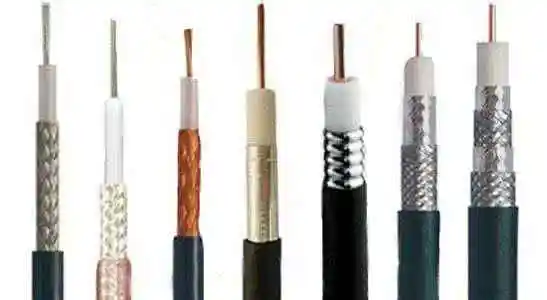
---------------------------------------------------------------------------------------------------
2、 what is the RF microwave test cable and classification?: RF microwave test cable: a common high-precision system test supplies; RF microwave coaxial test cable RF Microwave Coax Test cable is a common high-precision system test consumables in the field of wireless communications, and is used to connect with test instruments, the most common of which are vector network analyzers of Agilent, Rohde & Schwarz, Anrisu, etc. Frequency sweeper. Microwave coaxial test cable can be divided into three grades: 1. Military and aerospace grade, mainly characterized by very stable phase amplitude, high and low temperature resistance and other environmental factors, small VSWR, while the frequency reaches 26.5Ghz, 40Ghz, 50Ghz, 60Ghz, 75Ghz, 110Ghz. 2. Experimental grade: stable performance parameters, precision; III. Mass production test level; Durable and economical. In the early days, RF and microwave cables were basically monopolized by foreign manufacturers in the domestic market. According to sources, There are only a few domestic manufacturers that can compare with foreign manufacturers, such as Gore, Times Microwave Huber + suhner, Micro coax, Astrolab, IW, Megphase, Harbour. Its Rosenberger Radia ll Molex, but because of the use habits of most organizations, or certain interests, exclude domestic manufacturers.
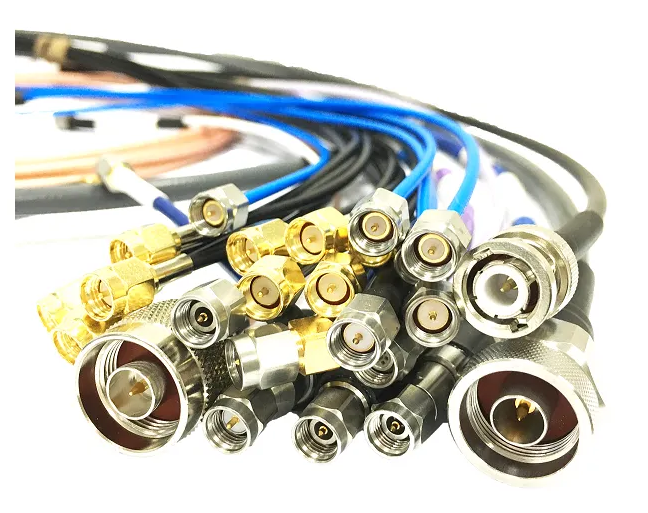
---------------------------------------------------------------------------------------------------
What are the main products of 3、 RF cable assemblies? : 1.0/2.3 Connector Cable Assembly | 1.6/5.6 Cable Assembly | 1.85mm Cable Assembly | 10-32 Cable Assembly | 2.4mm Cable Assembly | 2.92mm Cable Assembly | 3.5mm Cable Assembly | 3/4 "-20 Cable Assembly | 4.1/9.5 Mini DIN Cable Assemblies | 7/16DIN Cable Assemblies | 75 Ohm BNC Cable Assemblies | 75 Ohm F-Type Cable Assemblies | 75 Ohm N-Type Cable Assemblies | 75 Ohm RCA Cable Assemblies | 75 Ohm SMB Cable Assemblies | 75 Ohm SMC Cable Assemblies | 75 Ohm TNC Cable Assemblies | 75 Ohm Mini SMB Cable Assemblies | BNC Dual Shaft Cable Assembly | BNC Cable Assembly | C-Type Cable Assembly | FAKRA Cable Assembly | FME Cable Assembly | GR874 Cable Assembly | HN Cable Assembly | LC Cable Assembly | MC-Card Cable Assembly | MCX Cable Assembly | MHV Cable Assembly | MMCX Cable Assembly | NMO Rack Cable Assembly | N-Type Cable Assembly | QMA Cable Assembly Cable Assemblies | QN Cable Assemblies | SC Cable Assemblies | SHV Cable Assemblies | SMA Cable Assemblies | SMB Cable Assemblies | SMC Cable Assemblies | SMP Cable Assemblies | SSMA Cable Assemblies | SSMB Cable Assemblies | TNC Cable Assemblies | UHF Cable Assemblies | UMCX Cable Assemblies | Mini UHF Cable Assemblies
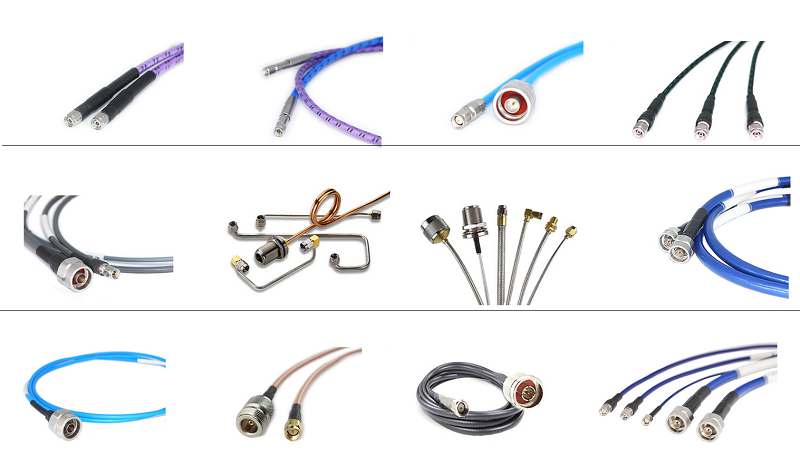
---------------------------------------------------------------------------------------------------
What are the main categories and series of 4、 RF cables, as well as their applications and characteristics? : RG Series: The RG series of RF cables is a series of coaxial cables originally defined by the US Army Standard. It is widely used in various industries. With the development of cable manufacturing technology and material technology, different manufacturers provide the same coaxial cable to the market to replace RG cable. Semi-flexible coaxial cable: Semi-flexible coaxial cable can be bent into shape by hand. Tin-impregnated braid is usually used, PE or FEP is commonly used for insulation sheath, and no insulation sheath is also a common method. Common 50ohm semi-flexible coaxial cables are divided into 0.047, 0.086, 0.0141 and 0.0250. Semi-steel cables: Semi-steel coaxial cables can be formed by using clamps or bending machines. Aluminum tube, copper tube, or stainless steel tube is usually used as the outer conductor. There is no insulating sheath. High-performance ultra-flexible microwave cable: High-performance ultra-flexible microwave cable has stable phase characteristics and amplitude characteristics. High stability in the range of mechanical dynamic applications and temperature variations. Low-noise cable: Low-noise cable is different from the ordinary coaxial cable, which can minimize the electrostatic noise generated by the cable itself. It is often used for the measurement of sensitive weak signals. Corrugated coaxial cable: Corrugated cable uses hollow copper tube as the inner conductor and corrugated copper tube or aluminum tube as the outer conductor. Has the characteristics of low loss, high power and the like. Flexible cable: Electrical performance can replace semi-steel or semi-flexible. 86 "and. 141" equivalent, with flexible characteristics, to meet the dynamic application and repeated bending. Leaky coaxial cable: Leaky cable is a coaxial cable in the outer conductor of the radiation window, in the signal transmission at the same time can play the role of the antenna. Commonly used in tunnels, indoor, locomotive, engine room and other signal coverage. Low-loss RF cable: Low-loss RF cable usually uses low-density PTFE as the insulation medium and single-core conductor as the inner conductor. Low-smoke and halogen-free RG cable: The environment-friendly low-smoke and halogen-free sheath can replace the standard RG cable. Triaxial cable: The structure of triaxial cable is similar to that of ordinary coaxial cable. There are three concentric layers of conductors separated by an insulator. It is commonly used in metrology testing and video transmission. Flexible semi-rigid cable: The flexible semi-rigid cable is a typical semi-rigid cable with the same physical structure. It uses a specially treated seamless copper tube as the outer conductor, which is different from the semi-rigid cable in its bending characteristics. It has the characteristics of flexibility and maintains the characteristics of stable amplitude and phase of the semi-rigid cable.
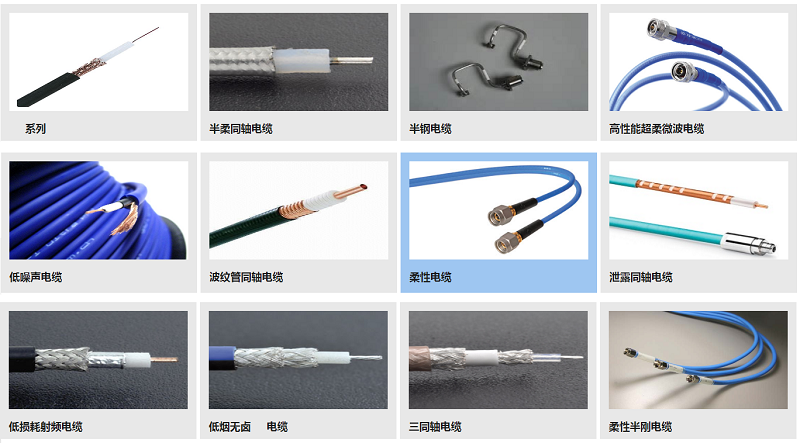
---------------------------------------------------------------------------------------------------
5、 some pictures of 50 Ω RF | microwave | millimeter wave high-precision coaxial cable | test cable and coaxial adapter products produced by our company (pictures are for reference only):
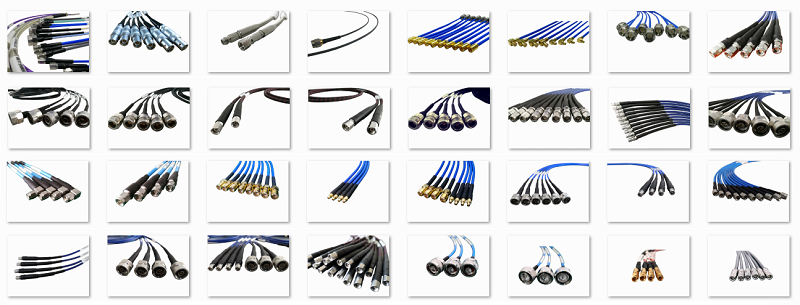
---------------------------------------------------------------------------------------------------
6、 how to purchase or learn about 50 Ω RF | Microwave | Millimeter Wave High Precision Coaxial Cable | Test Cable and Coaxial Adapter products? :